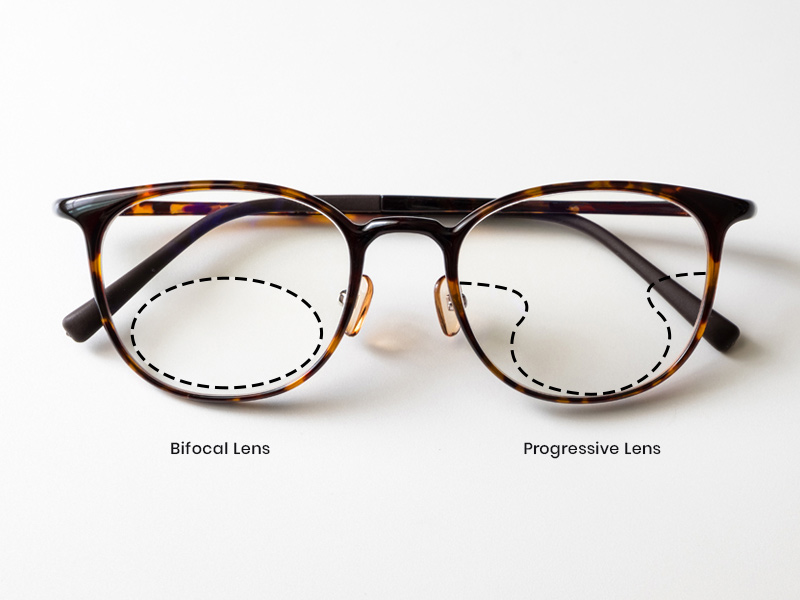Varifocals and bifocals are both types of eyeglass lenses designed to address vision issues related to presbyopia, a common age-related condition that affects near vision. While both types of lenses help individuals see at multiple distances, they differ in design and functionality. In this comprehensive comparison, we will explore the key differences between varifocals and bifocals, including their construction, benefits, drawbacks, and considerations for choosing one over the other.
Bifocals: Bifocals were invented by Benjamin Franklin in the late 18th century and consist of two distinct lens sections. The upper portion of the lens is used for distance vision, while the lower portion is designated for near vision.
Construction: Bifocal lenses are characterized by a visible horizontal line that separates the two lens sections. This line is called the "bifocal line," and it provides a clear visual indicator of the transition between the distance and near vision portions of the lens.
Optical Benefits: The primary advantage of bifocal lenses is their clear differentiation between distance and near vision. The abrupt transition at the bifocal line allows wearers to easily switch between the two focal distances by looking through the appropriate section of the lens.
Drawbacks: One of the main drawbacks of bifocals is the visible line, which can be aesthetically unappealing for some individuals. Additionally, the abrupt transition between the two lens sections can cause visual discomfort or distortion, especially during rapid shifts in gaze between distance and near objects.
Considerations: When considering bifocals, individuals should be aware of their specific vision needs and preferences. Bifocals are a suitable option for those who have distinct and predictable requirements for distance and near vision correction.
Varifocals: Varifocals, also known as progressive lenses, offer a seamless transition between multiple focal distances without the visible line found in bifocals. These lenses provide correction for distance, intermediate, and near vision within a single lens design.
Construction: Varifocal lenses feature a gradual progression of lens power from the top to the bottom, allowing wearers to seamlessly shift their focus between different distances without a noticeable line. Unlike bifocals, varifocal lenses do not have a visible segment division, offering a more natural and aesthetically pleasing appearance.
Optical Benefits: The main advantage of varifocals is their ability to provide continuous, natural vision correction at various distances. This design allows wearers to smoothly transition between far, intermediate, and near vision without experiencing the abrupt shift associated with bifocal lenses.
Drawbacks: While varifocals offer a more natural visual experience, some wearers may need time to adjust to the progressive nature of the lenses. This adjustment period, often referred to as "adaptation," can involve acclimating to the different zones of vision within the lens and learning to use the lens effectively for various activities.
Considerations: When considering varifocals, individuals should take into account their lifestyle and visual habits. Varifocal lenses are ideal for those who require seamless vision correction across multiple distances and desire a more discreet and aesthetically pleasing lens design.
Choosing Between Varifocals and Bifocals: When deciding between varifocals and bifocals, several factors should be considered to ensure the most suitable option for individual preferences and visual needs.
Lifestyle and Activities: Consider the specific activities and tasks that require clear vision at different distances. For example, individuals whose work involves frequent shifts between near and far vision may benefit from the seamless transition provided by varifocals. On the other hand, those with more predictable vision requirements may find bifocals to be a practical choice.
Aesthetic Preferences: Some individuals may have strong preferences regarding the appearance of their eyeglasses. Varifocals, with their absence of a visible line, often offer a more aesthetically pleasing option for wearers who prioritize a seamless, modern look. Bifocals, with their distinct bifocal line, may be less appealing from an aesthetic standpoint.
Comfort and Adaptation: Consideration should be given to the adjustment period required for both varifocals and bifocals. While varifocals offer a more natural transition between focal distances, wearers may need time to adapt to the progressive lens design. Bifocal wearers may experience quicker adaptation due to the clear differentiation between distance and near vision sections.
Prescription and Vision Needs: Individuals with complex vision prescriptions or specific visual challenges may find that one type of lens better suits their needs. It is important to consult with an eye care professional to determine the most appropriate lens option based on individual vision requirements.
In conclusion, varifocals and bifocals differ in construction, optical benefits, drawbacks, and considerations for wearers. While bifocals provide a clear differentiation between distance and near vision with a visible line, varifocals offer a seamless transition between multiple focal distances without the visible segment division. When choosing between varifocals and bifocals, lifestyle, aesthetic preferences, comfort, adaptation, and individual vision needs should all be considered. By understanding the distinct features and considerations associated with each lens type, individuals can make an informed decision to address their specific vision requirements.
Post time: Feb-04-2024

